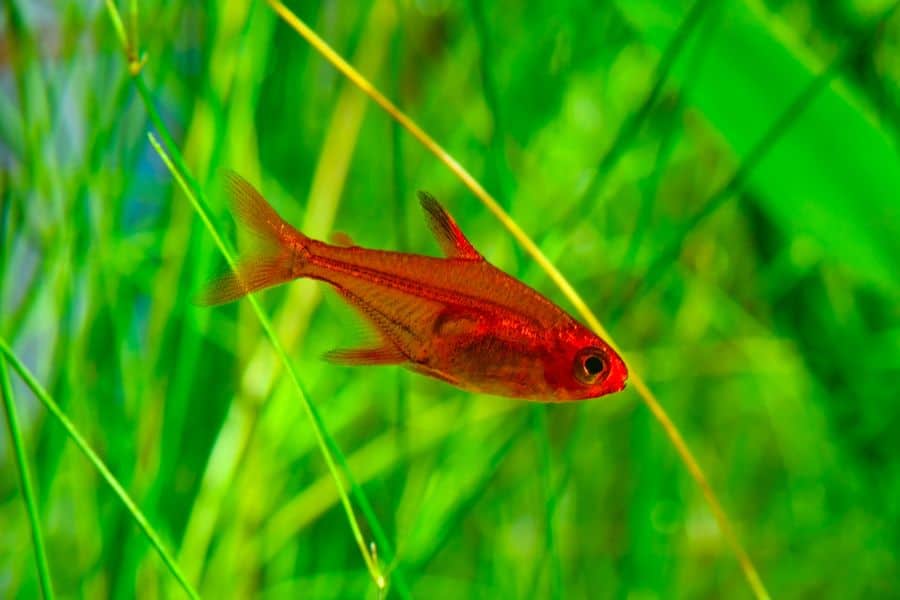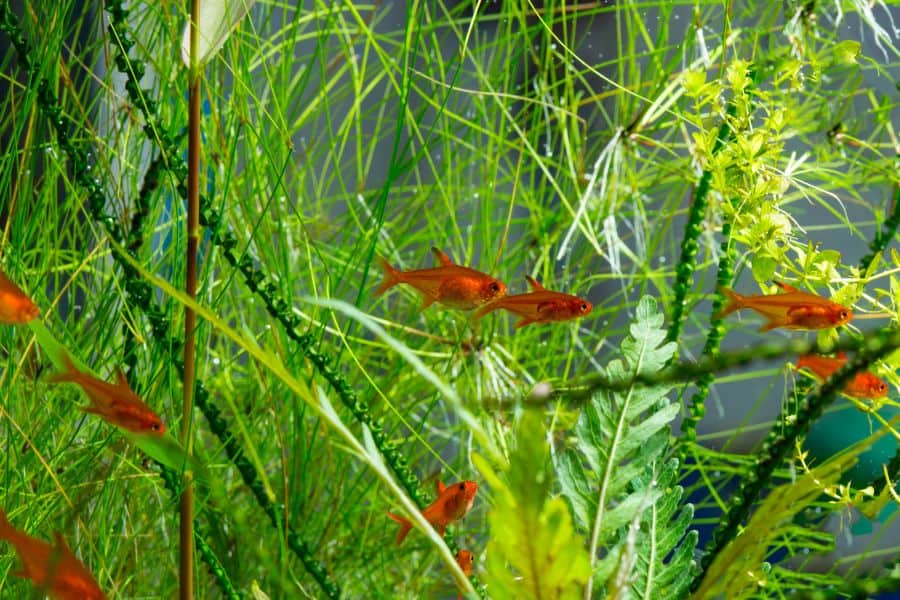Whether you’re an experienced fishkeeper researching a species to fit into your aquarium’s ecosystem, or you’re new to the hobby and are looking for a beginner species, the ember tetra is one of the best aquarium fish species to consider.
In this care guide, let’s discuss everything you need to know about caring for this beautiful and peaceful community fish.
Ember Tetra Basics
| Physical Traits | Ideal Tank Parameters | ||
| Scientific Name | Hyphessobrycon amandae | Water Type | Freshwater |
| Common Names | Fire Tetra, Reds, Dwarf Reds | Temperature Range | 72° to 80 °F or 22° to 26°C |
| Family | Characidae | Water Hardness | 4 to 8 dkH |
| Size | 2 to 3 cm | pH Range | 6.5 to 7.5 |
| Care Level | Easy | Water Flow | Gentle filtration |
| Activity Level | Highly active | Ideal Minimum Tank | 10 gallons |
| Diet | Omnivore | Minimum Number | 6 |
| Lifespan | 2 – 4 years | Planted Tank | Yes |
| Behavior | Breeding | ||
| Temperament | Peaceful | Difficulty to Breed | Easy |
| Compatibility | Community tank | Spawning Type | Egg scatterers |
| Group Behavior | Shoaling fish | Sexing | Larger females, brighter males |
Before we go into the specifics of the ideal care for tetra fish, let’s first look at five fun facts to get to know this species better!
- A loving namesake: The ember tetra’s scientific name, Hyphessobrycon amandae, was named after Amanda Bleher, the mother of a renowned German explorer and researcher.
- An inclusive shoal: Ember tetras are social creatures that love to shoal with other tetras, even if they’re not quite the same species.
- Touched by fire: With their deep orange coloration, ember tetras are also often referred to as “fire tetras.”
- Sexually dimorphic: They may seem identical at first glance, but female embers are a bit larger, while males have brighter and more vivid colors.
- Small but well-loved: Despite their tiny size, ember tetras hold a special place in the hearts of many fish enthusiasts.
Ember Tetra Origins
In 1987, scientists Weitzman, S.H. and L. Palmer (1997) discovered this new species of characin fish in the Araguaia River basin in Brazil.
These tiny freshwater fishes swam in large groups, their small size allowing them to navigate the dense plants and root systems of the Araguaia River with ease. They used the lush vegetation for cover, spawning, and hunting grounds for food.
They gave it the scientific name Hyphessobrycon amandae in honor of Heiko Bleher’s mother, Amanda Flora Hilda Bleher.
Heiko Bleher is a German researcher who has made thousands of discoveries and contributions to the fishkeeping community. He inherited his passion from his mother, who was a well-known explorer who settled in Brazil.
Together, the family became famous explorers of the Brazilian jungles, making numerous discoveries along the way. Eventually, Amanda and her husband decided to settle in Brazil. They ran a pet shop and were well known for importing and exporting other exotic animals.
Interestingly, Heiko’s grandfather, Adolf Kiel, was also a fan of aquariums — specifically aquatic plants. He held the nickname “Father of Water Plants” and was also attributed to being a pioneer in the art and science of aquarium keeping in modern times.
Ember Tetra Appearance
Ember tetras have very distinct features that set them apart from other tetra species. Here are some of their iconic characteristics.
- Ember tetras have a deep orange coloration, earning them the nickname “fire tetras.” Their vibrant and fiery hues resemble flickering embers under the right aquarium lights, creating a striking visual display in your tank.
- In addition to their vibrant hues, the ember tetra also has a silvery sheen to their scales, especially when exposed to direct light.
- The ember tetra has a sleek shape that reflects its lithe and active nature. Just like most other tetras, they have a slender knife-like body shape, perfectly suited for navigating through the dense vegetation of their natural habitat.
- Ember tetras have delicate, translucent fins that beautifully complement their fiery coloration. They have a pointy dorsal fin, often tipped with just the slightest hint of black and white colors and a distinctive anal fin that follows the shape of their body.
- One distinct feature of the ember tetra is their piercing black eyes, which are a striking contrast to their fiery body color.
Female vs. Male Ember Tetra
Sexing is important if you want to breed your tetras down the line. Fortunately, it’s quite easy to distinguish the differences between male and female ember tetras once you know what to look for.
- Female ember tetras have larger bodies compared to males. This is because they have larger swimming bladders, which are the organs used by these fishes to maintain buoyancy in the water.
- Males have a more streamlined shape to them compared to the females. The females are rounder, especially when it’s breeding season for them, as they have to accommodate the eggs that females carry.
- Males have a brighter and more vivid coloration compared to females.
Ember Tetra Size
Ember tetras are some of the smallest aquarium fishes in the hobby, but they’re also some of the most popular choices for community tanks.
Reaching a peak size of just about 2-3 centimeters in length, the ember tetra is tiny – certainly tinier than most freshwater aquarium fishes.
This makes them highly suitable for prey by many larger fish species, which is an important thing to consider if you’re planning on housing them in a community tank.
Being so small and yet so colorful does make them adorable and captivating additions to your aquarium, though. These bright, vividly colored pinpricks certainly add an exciting aesthetic appeal that won’t lose to their size.
Ember Tetra Lifespan
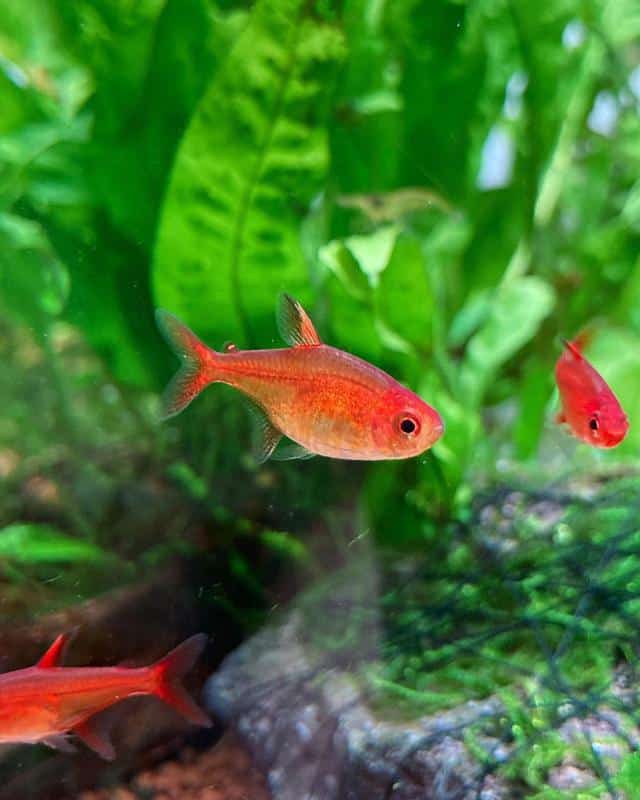
The ember tetra has a moderate lifespan for a tiny fish, living to around 2-3 years in a well-maintained aquarium.
Proper care, a balanced diet, and a suitable environment greatly contribute to their longevity. If you want your ember tetras to live a long and healthy life, remember to ensure optimal water conditions, regularly monitor your aquarium, and create a stress-free environment for them.
We’ll discuss the specifics of how you can keep your fish happy and healthy in the next few sections.
Ember Tetra Behavior and Temperament
Ember tetras are known for their peaceful and non-aggressive nature, making them excellent community fish for all kinds of aquariums.
Ember tetras also like grouping together into loose shoals, even with other tetra species.
Shoaling is a behavior by fishes and other aquatic animals where fishes, sometimes of different species, loosely swim together. It’s often confused with schooling, which is when large numbers of fish of the same species swim together to confuse predators or save energy.
Ember tetras are more of a shoaling than a schooling type, creating a vibrant and diverse community within your aquarium. That said, it’s still best to keep them with at least 5 other embers.
They’re pretty outgoing, but they do get a bit skittish when bigger fishes are nearby – and with good reason. Being one of the smallest fishes in the aquarium, they can easily be considered prey by the larger fishes.
That’s why if you’re including bigger fishes in your community tank, make sure that you provide a big space and dense cover for your ember tetras. We’ll discuss this more below.
Ember Tetra Tank Size
The ideal minimum tank size to house a shoal of ember tetras is 10 gallons. This gives them enough space to stretch their fins, so to speak, and for all their waste to be filtered properly. Keep in mind that they’re social creatures that will get stressed out if they’re alone. Again, you need to be able to house at least 6 ember tetras in your tank for them to feel more at ease.
How Many Ember Tetras per Gallon?
Being very small fishes, each ember tetra needs only about 1 to 1.5 gallons of space. This is going by the “one gallon per inch” rule.
Although you have to keep in mind that you should never keep just one ember tetra – which means 1-gallon tanks are a no-no for embers.
At a minimum, you should get six ember tetras, which bumps up the volume requirement to 6 to 9 gallons of water.
The ideal size of an ember tetra shoal for beginners is 6 to 8 gallons of water, so their ideal tank size will be about 10 gallons.
Ember Tetra Tank Setup
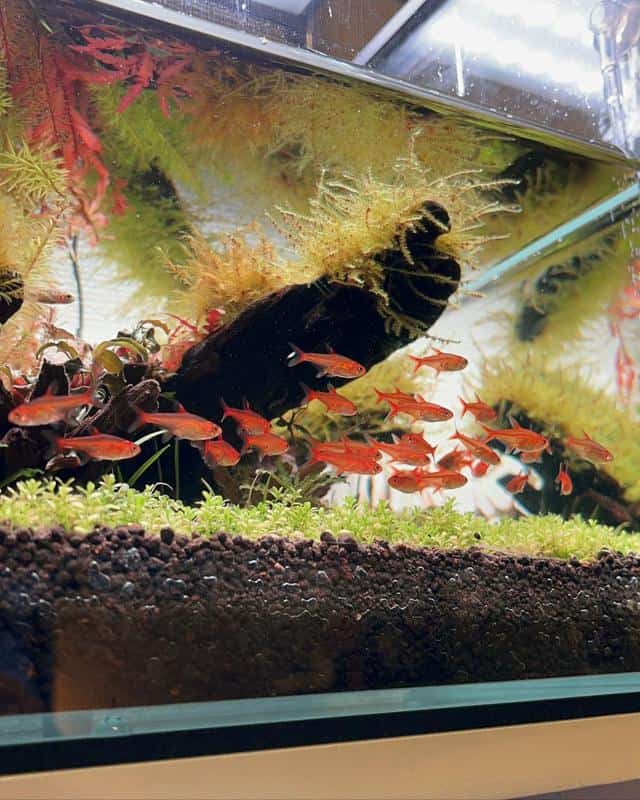
Creating the ideal tank setup for ember tetras involves replicating their natural habitat. This means simulating the gentle and lush environment of the Araguaia River basin, a tannin-rich environment with plenty of vegetation, rocks, and wood.
Ember tetras feel the most at ease swimming amidst “dark” waters that hide them from predators. They also appreciate a dense tangle of vegetation to hide in if a predator happens to be nearby.
So, if you want to set up your tank like the ember tetra’s natural habitat, you would do well to put plenty of live plants. Some of the best beginner-friendly examples include Amazon swords, hornwort, and dwarf sagittaria. These can develop into dense tangles that your ember tetras will love.
You should also incorporate lots of driftwood and leave litter to create hiding spots and exploration areas for these little explorers.
Lastly, consider using a blackwater setup. This is achieved by having organic matter that leaks tannins into the water, such as driftwood and dried almond leaves.
Not only does this jungle vibe fit their natural aesthetic better, but it also helps create a soft, acidic environment where they can thrive better. Also, it lets their vibrant colors stand out against the dark background.
Ember Tetra Temperature
Maintaining the appropriate water temperature is crucial for the well-being of ember tetras.
As tropical fish, the ideal temperature for ember tetras ranges from 72°F-80 °F or 22°C-26°C.
The best way to maintain this temperature is to use a trusty aquarium heater, like MarineLand Precision Heater or Tetra Submersible Heater.
Ember Tetra Water Parameters
While the ember tetra is a hardy fish species that can thrive in many different environments, you should still prioritize mimicking their natural water parameters as closely as possible.
They prefer a slightly acidic to neutral pH level between 6.5 to 7.5 and a water hardness of around 4 to 8 dkH. Don’t forget routine water changes, and use a reliable filtration system with a gentle flow to keep the water clean.
Ember Tetra Diet
Ember tetras are omnivorous, which means they eat both plants and other animals.
As one of the smallest species of aquarium fish, they have a small mouth suited for consuming small food particles. We recommend giving them a varied diet that includes high-quality flake or micro-pellet foods formulated explicitly for small tropical fish.
It would help if you also supplemented their diet with live or frozen fish food like daphnia, brine shrimp, and micro worms to enhance their overall nutrition and support their vibrant colors.
Feed only what they can eat in about a minute or two, and never feed more than twice a day to prevent bloating or constipation.
Ember Tetra Tank Mates
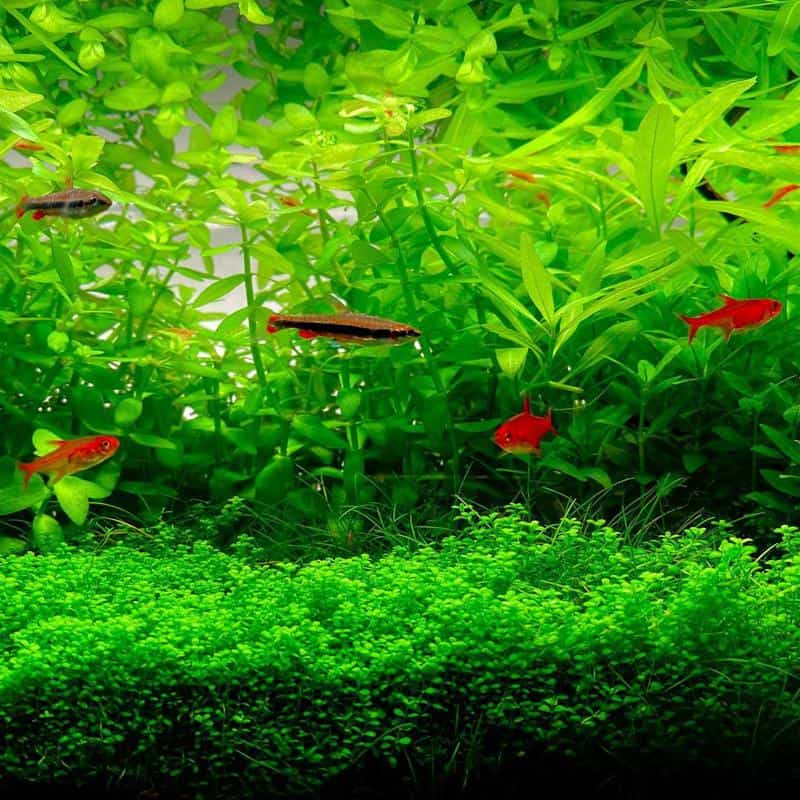
This species of fiery red fish may be an ideal community aquarium inhabitant, but that doesn’t mean they’ll get along well with every other species of fish out there.
Because of their small size, you need to take special consideration when choosing tank mates for your ember tetra. In this section, we’re going to list down the best ember tetra tank mates you can get for your community tank.
- Other tetras: First on the list are other kinds of tetras with similar sizes. Ember tetras regularly shoal with other tetras, as long as they’re not too big. Some of the best options include neon tetra, glowlight tetra, and cardinal tetra.
- Pygmy Corydoras: These tiny bottom-dwelling catfish are a great match for Ember Tetras due to their peaceful nature and similar size.
- Harlequin Rasboras: Ember tetras can form a beautiful shoal with embers. These fishes are also active and rarely get into fights.
- Otocinclus Catfish: Also called otos, these algae-eating catfish can help keep the aquarium clean while coexisting peacefully with ember tetras.
- White Cloud Mountain Minnows: Zebra Danios make a great addition to any community tank with ember tetras, especially since they share similar parameters.
- Zebra Danios: If you want something zipping alongside your ember tetras, you’ll love these active fish.
- Endler’s Livebearers: Endler’s livebearers are lively, non-aggressive, and small enough to be compatible with ember tetras.
- Cherry Shrimp: These small, non-aggressive invertebrates make interesting tank mates, providing a pop of color and entertainment to your ember tetra tank.
- Nerite Snails: Small and unassuming, nerite snails provide no threat to the ember tetras. They help clean the tank of any uneaten food and organic matter, as well as add a visual appeal to your tank with their interesting patterns and colors.
Ember Tetra Common Diseases
We want our fiery little ember tetras to live happy and fulfilling lives, which means that we don’t want them to get sick.
To minimize the chances of that happening, you should know about the most common diseases this fish species can suffer from, such as the following.
- Ich (White Spot Disease): A common freshwater fish disease, ich is characterized by small white spots on the fish’s body, though it can easily be treated with medication and proper water conditions.
- Fin Rot: This bacterial infection affects the fins, causing deterioration and fraying. It’s often caused by poor water quality or injuries. Maintaining clean water and using appropriate medications can help treat and prevent fin rot.
- Impaction: Because of their size, ember tetras can be prone to impaction – a sort of indigestion that blocks digestive tracts and can cause severe consequences. It can occur when this species overeat or eat dried food.
Ember Tetra Breeding
Breeding ember tetras can be a fun and fulfilling aspect of the hobby. Fortunately, getting this species to produce offspring isn’t rocket science and can be done by everyone. Here’s how!
- Select a breeding pair: Choose healthy and mature ember tetras for breeding.
- Create ideal breeding conditions: Set up a separate breeding tank with soft, acidic water, dense vegetation, and gentle filtration.
- Introduce the pair: Place the male and female in the breeding tank and provide hiding spots or spawning mops for the eggs.
- Spawning and egg collection: The female will scatter adhesive eggs among the plants. Remove the adults after spawning to prevent them from consuming the eggs and fry.
- Egg incubation: Eggs hatch in 24-48 hours. Provide proper water conditions, gentle aeration, and dim lighting to promote fry development.
- Feeding your fry: Once they’ve hatched, feed your baby ember tetras some infusoria or specialized fry food until they are large enough to consume small life or crushed dry foods.
Also Read:
FAQs
Are Ember Tetras Good Beginner Fish?
Ember tetras are a good species to have for a beginner aquarist. Despite having some special requirements (mostly because of their small size), this fish species is quite hardy and can tolerate different environments.
How Many Ember Tetras Should I Keep Together?
Ember Tetras are shoaling fish and thrive in groups of at least six individuals. Keeping them in larger groups creates a more natural and engaging display. Not to mention, it keeps them happy and active, while keeping them alone will only stress them out.
Can Ember Tetras Be Kept with Other Fish?
Ember tetras are peaceful fishes that can be kept in a community aquarium. However, keep in mind that they will most likely become prey if the other fish in the tank are significantly bigger than they are. Provide ample space and adequate cover to avoid predation.
Conclusion
Ember tetras are a unique and interesting peaceful fish species that can provide a rewarding challenge for new and veteran fish keepers alike. Keeping this fish is relatively straightforward but requires planning to execute properly, especially regarding tank setup and tank mates.
But with all the information in this article, we’re sure you can keep ember tetras happy in their new tank setup!
